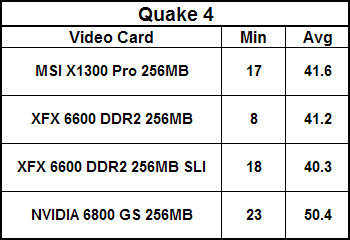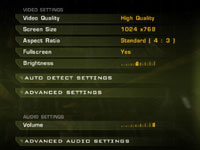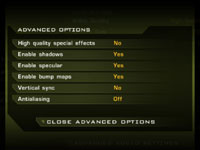Quake 4
Publisher: ActivisionWe used the full retail version of Quake 4, the fourth game in the Quake series, based on the technically sound Doom 3 engine. However, unlike Doom 3, we found that the game benefits from at least 2x Anti-Aliasing, and the experience with Anti-Aliasing at a slightly lower resolution was better than increasing the resolution with no AA applied.
Both Anti-Aliasing and Anisotropic Filtering were controlled from inside the game. When you select "High Quality" mode, 4xAF is automatically enabled, and when the "Ultra Quality" mode is enabled, 8xAF is automatically applied to the scene.
We did a manual run through from a five minute section of the Nexus Hub Tunnels level and found that a minimum of 15 frames per second and an average of 40-50 frames per second in our test section was deemed to be playable across the rest of the title.


Even 800x600 with Medium Quality wasn't 100% playable, and we found that disabling specular lighting really helped matters and the frame rate was much smoother. Disabling specular lighting meant that the lighting was noticeably less vibrant than it was when specular lighting was turned on. We don't think the Radeon X1300 Pro benefited from the driver tweaks in Catalyst 5.11, which were designed to increase ATI's Radeon X1000-series OpenGL performance.
The XFX GeForce 6600 DDR2 was in a completely different league to the Radeon X1300 Pro in Quake 4. We found that 1024x768 0xAA 4xAF High Quality was perfectly playable. You will notice that the minimum frame rate we recorded was a mere 8 frames per second, but that is slightly misleading.
We suffered a slight stutter when we went through the auto save point in our manual run through, and that meant that the frame rate dropped uncharacteristically low. If we were to disregard this 'save game' stutter, the minimum frame rate was a perfectly acceptable 18 frames per second. This happened on three occasions during three different manual run throughs, so we feel that it is 'normal' for this portion of the game on a GeForce 6600 DDR2. Thankfully, there is no fighting going on during the save game point so the slight stutter isn't all that important.
When we added a second XFX GeForce 6600 DDR2 into the fray, we found that we were able to improve the highest playable image quality with 2xAA. The frame rate stayed in the same region as in single card mode, but with the increased image quality. This time, we didn't experience the same 'save game' stutter that we did on the single XFX GeForce 6600 DDR2 card.
As with F.E.A.R. we found that the GeForce 6800 GS was faster than the XFX GeForce 6600 DDR2 SLI. However, it wasn't fast enough to increase the highest playable image quality any further. We just experienced a much smoother gaming experience than we did on any of the other video card configurations we tested on this particular occasion.

MSI MPG Velox 100R Chassis Review
October 14 2021 | 15:04








Want to comment? Please log in.